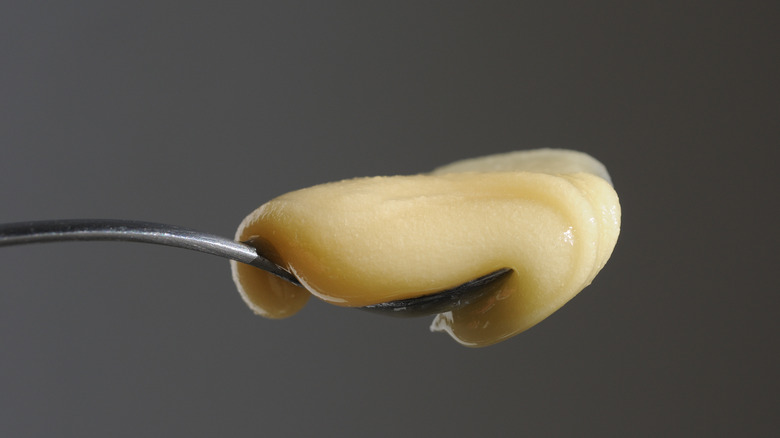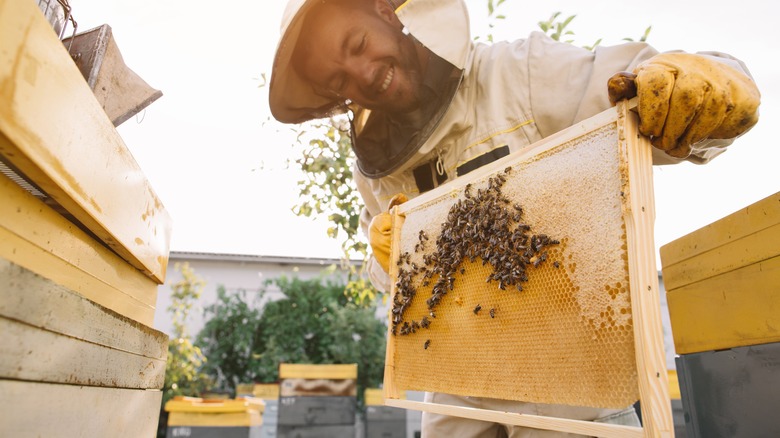What Is Creamed Honey And Is It Sweeter Than Regular Honey?
Honey has been used as a sweetener since ancient times. It's been used in foods, medicines, and candies. The ancient Egyptians were the first to cultivate honey — but in the millennia since, humans have refined the process in several ways.
In 1928, Professor Elton J. Dyce of Cornell University developed a new method for processing honey. He claimed his invention was superior to the standard honey products you can buy at the store. In its unpasteurized state, honey tends to harden and form coarse crystals, Dyce explained. Alternatively, the texture of pasteurized honey is drippy and thin. Dyce's method produced a soft, smooth honey with a thick consistency and a light, creamy color — the perfect solution.
This is called "creamed honey," also known as whipped honey, spun honey, churned honey, or honey butter. However, despite its advantages, creamed honey has never really caught on commercially. Reports show that customers mistakenly assume that the product is moldy and miss out on the buttery-smooth treat.
What exactly is creamed honey?
Based on its name and milky appearance, you might assume that creamed honey contains dairy, but unlike treats like honey whipped cream, creamed honey only contains one ingredient: pure, raw honey.
Raw honey is the unpasteurized version of the honey you typically find at supermarkets — the purest form, straight from the hive. Many people love raw honey, but if you've ever bought it for yourself, you've likely noticed that it begins to crystalize after a few months.
When honey crystallizes, it changes from a glassy, viscous liquid to a hard, grainy solid. While crystallized honey is perfectly safe for consumption, most people find the texture unappealing. So what should you do with crystallized honey?
Well, one option is to turn it into creamed honey. The Dyce method involves controlling the crystallization process so the crystals are smaller and more evenly shaped than the ones that occur naturally. This gives creamed honey its smooth, buttery texture. It may sound complicated, but you don't need any special equipment to make it. With a little time and patience, you can learn to make creamed honey in your own kitchen.
How is creamed honey made?
Making creamed honey is fun, but you shouldn't expect instant results. Before starting your project, keep in mind that it'll take a week or two before your honey is ready. The quickest and easiest method is, well, to buy it at a store. But once you've bought one jar, you'll never have to buy more. Like a sourdough starter, pre-made creamed honey helps "seed" raw honey so crystals can grow.
To make creamed honey with a "starter," mix one part creamed honey into ten parts raw liquid honey. Ensure your liquid honey hasn't started to crystalize — you don't want gritty crystals in your finished product. Once the honey has been thoroughly combined, jar it and refrigerate it for one to two weeks to let crystals form.
You can also make creamed honey from crystalized honey. Combine crystalized honey and raw liquid honey in a stand mixer and run it for 20 minutes. Cover it and let it rest for a few hours, then repeat. Repeat the process three or four times, put it in a jar, and refrigerate it for a few weeks.
Even though creamed honey is often called "whipped honey," the goal is to break down the sugar crystals, not whip air into the honey. In fact, you should avoid mixing too much air into the honey. According to Elton J. Dyce's patent, air bubbles can ferment the honey and give it an unpleasant appearance.
Where can you buy creamed honey?
Looking for creamed honey to "seed" your own batch? Check grocery stores, where it's often sold alongside liquid honey. If you can't find it on the shelves at Kroger, check a specialty or health food store. You can also ask at farmers' markets to see if any local beekeepers sell it. If all else fails, check online.
If you're just not into the DIY process, there's no shame in buying commercially made creamed honey. However, be prepared for a pricier product since creamed honey has higher production costs than most other types.
However, if you don't mind the price, you may end up with a better product. Store-bought creamed honey typically has a smoother texture than the stuff you'd be able to make at home, as commercial honey producers have better equipment and more time to devote to perfecting their recipes.
Nutritional information about creamed honey
Honey is highly nutritious — and creamed honey is no exception. According to the National Library of Medicine, honey has been used medicinally for over 8,000 years to treat everything from hepatitis to hiccups. Though not all of these purported medicinal uses are backed by modern science, honey still has an impressive list of health benefits. Honey is anti-bacterial, with anti-inflammatory and antioxidant properties. Medical-grade honey can be used topically to help heal wounds and burns, and studies suggest that it could treat a host of other medical conditions, too. There's evidence that honey could help treat gastrointestinal issues, heart disease, and depression.
While honey has more calories than sugar, Healthline notes that it's often seen as a healthier alternative. It's better for regulating blood sugar, too, so some people with diabetes use it as a substitute. Still, use it in moderation.
You may already use honey medicinally, as a common remedy for a cough or sore throat. WebMD suggests that using honey as an alternative to cough syrup could be particularly beneficial to children since over-the-counter cough medications aren't recommended for young kids. Don't feed honey to babies, though. Children less than a year old haven't built up resistance to the germs or spores sometimes found in honey, so they're at high risk of developing botulism. According to one study, roughly 20% of cases of infant botulism reported in the U.S. each year are related to honey.
How is creamed honey different from regular honey?
Creamed honey is essentially crystallized honey — just processed to be more palatable. The crystallization process doesn't change the taste much, but you may find that crystalized honey has a different flavor than supermarket honey. When and where honey is produced can have a significant impact on flavor. The commercial honey brands you're used to blend different kinds of honey together to get a uniform taste. Creamed honey is often locally made from raw honey, so you'll get the full benefit of nuanced local flavors.
Depending on the method used, creamed honey may or may not be pasteurized. To pasteurize honey, producers heat and filter it to kill yeast and remove impurities. Conversely, raw honey is packaged and sold straight out of the hive.
Commercially-made creamed honey is pasteurized as part of the Dyce method, but most at-home recipes leave the honey raw. Raw honey could have additional health benefits, but studies are inconclusive.
How to cook with and use creamed honey
You can use creamed honey for just about anything you'd use regular honey for — as a sugar substitute, natural flavor, or even a home remedy. If you enjoy using creamed honey, you may want to stop using the regular stuff altogether. But since it can be costly or labor intensive, you may want to reserve it for special occasions.
Also, it's important to know where it's best deployed. If you're baking it into a cake or stirring it into a cocktail, creamed honey's best feature — its texture — will be lost.
Creamed honey works particularly well as a spread: the thick, buttery texture has a pleasing mouthfeel and is less prone to drips than other types, so it's the perfect topping for toast, bagels, or scones. It makes for a creative addition to a charcuterie board, too. The texture makes it easy for guests to use as a dip or spread without making a sticky mess. Mix and match it with sweet and salty ingredients like nuts, fruit, cheese, or cured meat.






